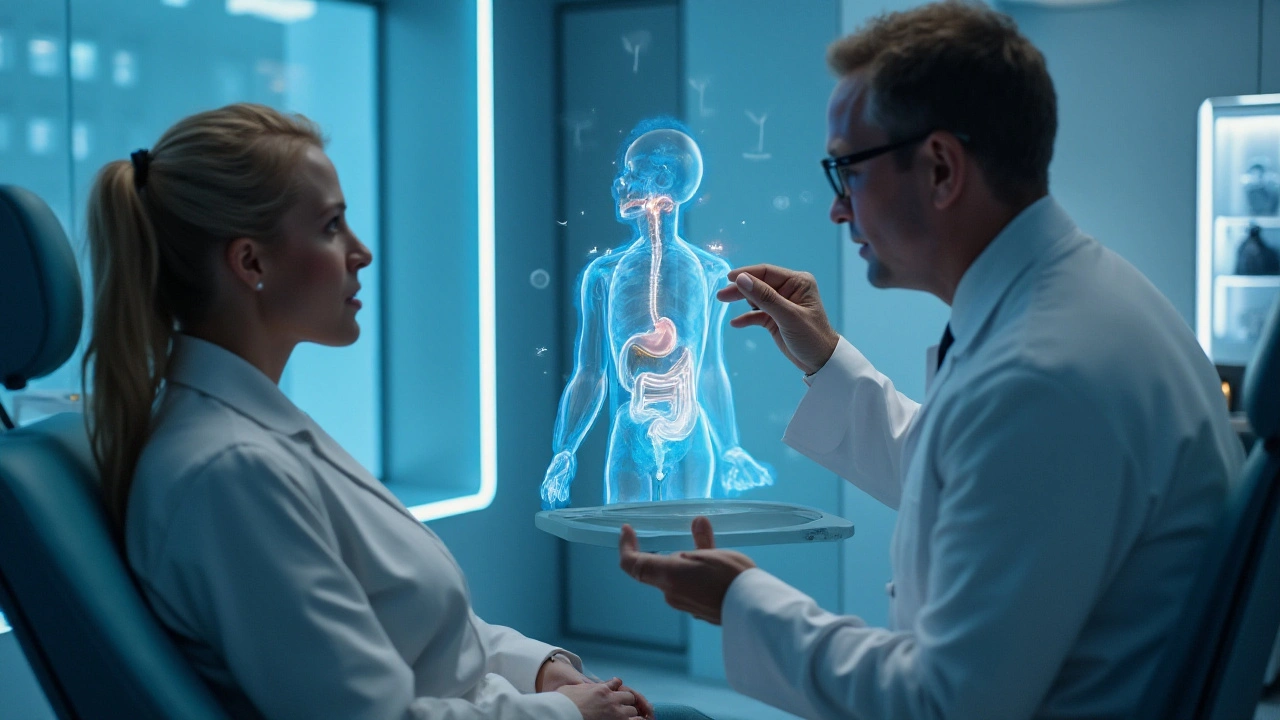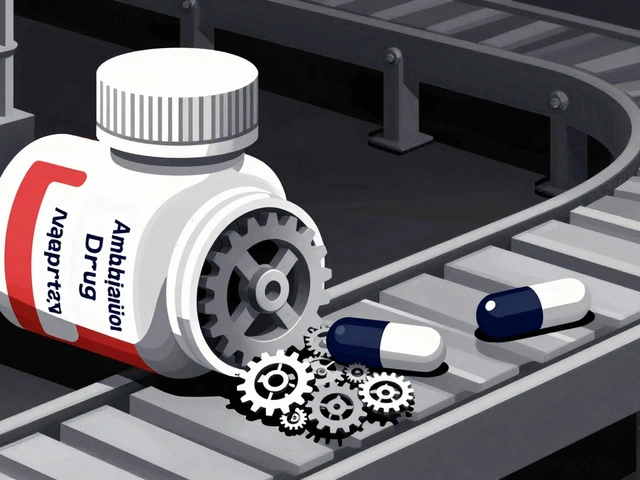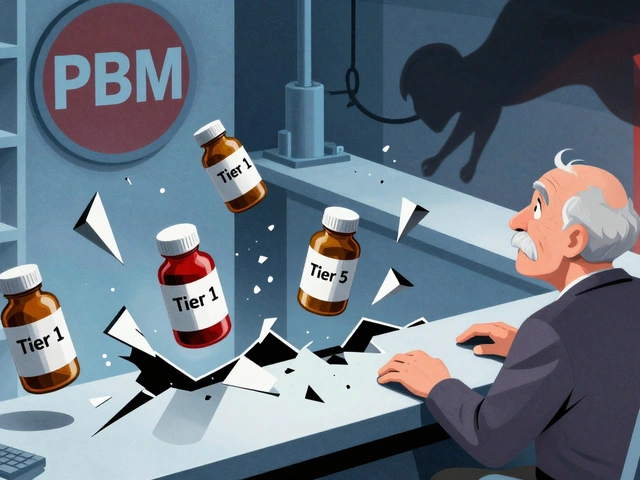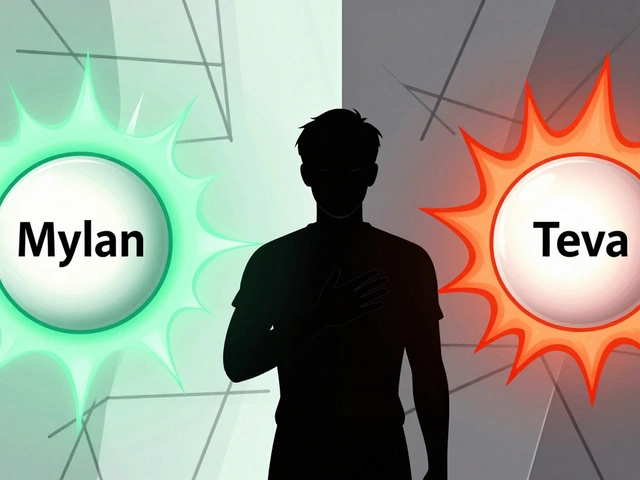
Managing digestive issues can be a daunting challenge, especially when you're dealing with persistent symptoms like nausea and slow gastric motility. Fortunately, there are numerous alternatives to Motilium available today, each with its unique profile of benefits and limitations.
This guide presents nine noteworthy options, from pharmaceuticals like Metoclopramide and Prucalopride, to more unconventional methods such as Botox Injections and Medical Cannabis. By understanding these alternatives, patients and healthcare providers can collaborate to tailor a treatment plan that best suits the individual's needs, aiming for effective symptom relief and improved quality of life.
- Metoclopramide
- Prucalopride
- Erythromycin
- Nabilone
- Botox Injections
- Gastric Electrical Stimulation
- Medical Cannabis
- Itopride
- Cisapride
- Conclusion
Metoclopramide
Metoclopramide has been a staple in the realm of treating digestive disorders, much valued for its ability to combat nausea and vomiting. It stands out among other Motilium alternatives by its mechanism as a dopamine antagonist, which not only alleviates unpleasant symptoms but also works effectively in speeding up the gastric emptying process. This characteristic makes it especially useful for individuals experiencing troublesome digestive issues, like gastroparesis. Known under brand names such as Pramin, Reglan, and Metonia, it's widely accepted in medical practices across the globe.
The way Metoclopramide accelerates digestive transit provides relief for symptoms associated with delayed gastric emptying, a condition that can impair one's quality of life significantly. By ensuring more efficient digestion, it lessens the severity of the bloating and fullness that often accompany these disorders. What sets this medication apart is its additional use in patients with acid reflux; many have found improved comfort post-treatment. Yet, like all medications, it comes with its share of potential side effects.
A prominent concern around Metoclopramide revolves around the risk of developing Tardive Dyskinesia, a condition that can cause serious, and sometimes irreversible, movement disorders. This risk necessitates a cautious approach, often limiting its long-term use. Other associated side effects include Neuroleptic Malignant Syndrome and neurological twitches, which highlight the importance of consulting with healthcare professionals before embarking on a treatment plan with Metoclopramide. “Prescribing Metoclopramide should always balance the benefit-to-risk ratio closely,” advises Dr. Annabelle Tufts, a noted gastroenterologist.
While Metoclopramide remains a vital tool against certain digestive ailments, what remains crucial is the dialogue between patient and doctor to tailor the treatment to the individual's needs, considering both efficacy and potential risks. Patients are encouraged to monitor their reaction to the medication closely and report any adverse effects promptly, enabling adjustments to be made as necessary. The ongoing development of new treatments and understanding of existing ones continues to offer hope to those seeking relief from complex digestive disorders. This evolving landscape underscores the importance of remaining informed and proactive in one's healthcare journey.
Prucalopride
Prucalopride emerges as a significant player in the realm of digestive treatments, particularly for those grappling with chronic constipation. Developed as a selective serotonin 5-HT4 receptor agonist, this drug works magic on the gut's motility, making it a viable option for enhancing bowel movements. Originally designed to serve primarily women battling ongoing constipation issues, Prucalopride has also found favor in the off-label treatment sphere for gastroparesis, marking its versatility in addressing a range of digestive challenges. It is marketed under brand names like Resotran and Resolor, each recognized for their ability to facilitate smoother transit times through the intestinal tract.
One of the compelling aspects of Prucalopride is its targeted approach. The medication revs up the serotonin receptors in the digestive tract, influencing the muscular activity and enhancing peristalsis. Unlike many alternatives that affect a wide range of receptors, Prucalopride zeroes in on 5-HT4, minimizing some of the broad-spectrum side effects that often accompany treatments with more comprehensive targets. This precision doesn't just improve efficacy; it can also make living with long-term treatments more bearable for patients. Interestingly, studies have shown that Prucalopride effectively induces bowel movements in patients where other drugs have failed, marking it as a potential lifeline for those seeking reliable relief.
The relief provided by Prucalopride is often swift, manifesting within hours for many users, which is a testament to how it targets gut motility directly. The efficacy of Prucalopride can be attributed to its unique way of working as a prokinetic, which helps propel food more effectively through the stomach and intestines. Such features make it particularly suitable for individuals who have not experienced adequate outcomes with other medications. In fact, a clinical trial revealed improvement in colonic transit time of 14.9 hours to about 10.1 hours among users taking the drug, signifying a noteworthy boost in motility.
Though Prucalopride is generally well-tolerated, it comes with some caveats. Patients and healthcare providers must weigh the benefits against potential side effects, which can include headaches, dizziness, and nausea. In some cases, the modulation of serotonin receptors could result in unexpected reactions that necessitate adjustment or discontinuation of treatment. Nevertheless, these occurrences are often rare, and the majority of users find that the advantages far outweigh any minor, transient discomfort.
Many experts believe that treatments like Prucalopride represent the future of personalized medicine in the field of gastrointestinal health. Its precise mode of action aligns with the growing demand for drugs that cater to individual physiological needs without imposing a significant risk of side effects. The off-label application for gastroparesis adds yet another layer to its versatility, suggesting that this could eventually become a more widely accepted treatment in both clinical and residential settings. As researchers continue to explore its full potential, individuals suffering from digestive disorders could find hope in this adaptable drug. As Dr. Jane Ellis commented,
"Prucalopride is a breakthrough in targeted gastrointestinal therapies, balancing efficacy with a commendable safety profile."
Erythromycin
Erythromycin, primarily recognized as an antibiotic, has gained attention for an intriguing side role in addressing digestive troubles. Unlike its conventional function in combating bacterial infections, erythromycin finds a place in enhancing gastric motility by acting as a motilin receptor agonist. This dual-action mechanism makes it a compelling choice for individuals with conditions such as diabetic gastroparesis. By mimicking motilin, a naturally occurring gut hormone, it encourages the swift clearance of stomach contents, easing symptoms of nausea and fullness.
While the benefits are significant, erythromycin's role as a motility agent didn't begin with this intention. It was through exploring its side effects that researchers identified a useful application beyond its antimicrobial properties. Those with digestive disorders might find relief using erythromycin, particularly when traditional treatments fall short. However, as with any medication, there's a complex balance between therapeutic benefits and potential downsides. Patients often need to discuss extensively with healthcare providers about its off-label use, considering both the relief of symptoms and its antibiotic-related risks.
Nausea remedies that double as antibiotics pose unique challenges. Recent studies have exposed the concern of antibiotic resistance when medications like erythromycin are used beyond their primary purpose. A large-scale review in digestive health revealed promising results but flagged the delicate consideration required in prolonged use due to potential microbiome disruption. It's this ambiguous terrain that healthcare professionals navigate when prescribing erythromycin for digestive issues.
Pros
- Improves gastric emptying times.
- Useful for diabetic gastroparesis.
- Offers relief for some digestive disorders.
Cons
- Primarily an antibiotic, not designed for gastroparesis.
- Potential for antibiotic-related side effects.
- Requires careful discussion with medical professionals.
The complex role of erythromycin in treating digestive problems is a testament to the shifting landscape of gastroparesis treatment. It's not every day that a medication known for infection control transitions into a tool for easing stomach motility. Yet, the evolving use of erythromycin hints at broader trends in medical science, where understanding one facet of a drug unlocks possibilities within another.
“Exploring the dual roles of antibiotics like erythromycin reveals an innovative frontier in medical treatment. It's imperative that we proceed with caution, understanding both potential benefits and inherent risks,” says Dr. Nathan Williams, a leading gastroenterologist in digestive therapies.
In the drive to find effective Motilium alternatives, erythromycin stands out, not just for its innovative application but for the way it challenges both patients and practitioners to reconsider how we define 'side effects'. The journey of this medication from the realm of bacterial infections to digestive relief underscores how intricate and interconnected bodily systems can be.

Nabilone
Nabilone is an intriguing option within the Motilium alternatives spectrum, primarily utilized for its potent antiemetic properties. Originating from the class of synthetic cannabinoids, Nabilone mirrors some aspects of THC, the active component found in cannabis. Its creation was aimed at providing a controlled alternative to naturally derived cannabinoids, particularly for patients battling severe nausea and vomiting. Such symptoms often prove resistant to traditional treatments, making Nabilone a valuable tool in clinical settings, including oncology where chemotherapy-induced nausea can be debilitating. This cannabinoid analogue works intricately within the body’s endocannabinoid system, regulating nausea and effectively improving patient comfort.
While Nabilone is renowned for its effectiveness, it also carries the prototypical caution associated with cannabinoid therapies. The potential for side effects akin to those found with recreational or medical cannabis requires careful medical oversight and guidance. Users may experience dizziness, drowsiness, or changes in mood, which can influence daily activities. Therefore, it's crucial that patients engage in open discussions with their healthcare providers before embarking on treatment with Nabilone, balancing benefit against potential side effects. The dualistic nature of its effect — both reassuring in its medicinal potential and cautionary due to side effects — makes it a subject of continuous study and debate. Indeed, as Dr. Rebecca Tomas, a leading oncologist, remarks,
“Nabilone provides a clever alternative to traditional antiemetic therapies, expanding options for patients who need them most.”
The advent of Nabilone into clinical practice has not only broadened the landscape of antiemetic medications but also illuminated the versatility of cannabinoid-based treatments. This medication is typically prescribed in strict dosages, adjusted according to patient response and tolerance levels. Healthcare practitioners must consider a multitude of factors including the patient’s medical history, the severity of symptoms, and concurrent treatment regimens. This tailored approach ensures maximized benefits while minimizing unwanted effects. With the increased dialogue surrounding medical cannabis, Nabilone remains a pertinent example of synthesized cannabinoids offering legitimate therapeutic benefits while operating within legal and regulatory frameworks.
Interestingly, Nabilone's utility extends beyond the confines of cancer treatment. Research and anecdotal evidence suggest potential benefits in treating conditions like anxiety and post-traumatic stress disorder (PTSD), where traditional pharmaceuticals may fall short or induce unwelcome side effects. Nonetheless, such applications are in formative stages and require substantial clinical validation. As medical professionals continue to understand and harness Nabilone’s potential, the emphasis remains on responsible prescribing practices. This ensures patient safety and efficacy are maintained throughout the treatment process. The evolution of Nabilone illustrates the broader trend of embracing alternative treatments in modern medicine, particularly in areas where traditional options have plateaued in terms of innovation and effectiveness.
Botox Injections
Botox, commonly known for its cosmetic use, has also made its way into the treatment of digestive ailments, especially conditions like gastroparesis. This might come as a surprise to many, but Botox injections can be a potential alternative for those not finding relief from traditional medications like Motilium. The treatment works by relaxing the muscles of the stomach, specifically targeting pyloric sphincter dysfunction, to enhance gastric emptying times. This is particularly beneficial for those who suffer from delayed gastric emptying where the stomach muscles do not function properly. It's quite fascinating how a substance known for smoothing wrinkles can also help smooth out the digestive process.
One might wonder how exactly Botox, a neurotoxin, can be safely used in the stomach. The key lies in the controlled use and administration by trained medical professionals who inject small doses directly into the stomach muscles. This localized approach minimizes any systemic effects and largely focuses the action where it's needed the most. According to a study published in the American Journal of Gastroenterology, Botox injections have shown promising results in reducing symptoms of nausea and bloating, leading to improved quality of life for patients with refractory gastroparesis.
"The utilization of botulinum toxin in gastrointestinal treatments is a testament to its versatility and expanding therapeutic repertoire," says Dr. Elaine Thomas, a leading expert in gastroparesis research.
However, like any medical treatment, Botox injections are not devoid of limitations. They are considered an invasive procedure compared to oral medications, which might deter some patients. Additionally, the relief provided by Botox is often temporary, necessitating repeated sessions for sustained benefits. Patients often need to weigh the pros and cons, including the cost and the intrusiveness of the procedure, against the severity of their symptoms and the lack of response to other treatments. Digestive relief through Botox might be a viable path, but it's crucial to consult with healthcare providers to tailor approaches to individual conditions. If undergoing the procedure, patients might experience some initial discomfort which usually subsides as the body adjusts.
To better understand the placement of Botox in the landscape of alternative treatments, it's beneficial to look at comparative effectiveness. The convenience of oral medications like Prucalopride or Medical Cannabis can offer an easier alternative, but may not provide the targeted action of Botox on the stomach muscles. Potential users should discuss their options extensively with their gastroenterologist to determine the best course for managing their gastroparesis symptoms. While it's not a universal remedy, Botox injections offer a beacon of hope for patients whose conditions have been resistant to conventional approaches. The versatility of Botox, extending from the cosmetic arena into therapeutic uses in digestive health, continues to captivate both the medical community and patients alike.
Gastric Electrical Stimulation
Gastric Electrical Stimulation (GES) is a surgical procedure designed to provide relief for those suffering from severe gastroparesis, a condition where the stomach takes an unusually long time to empty its contents. For some, it's become a beacon of hope, particularly when traditional treatments fall short. By implanting a small device into the stomach, GES delivers mild electrical pulses to the stomach muscles, which help improve their contractions and thus facilitate digestion. This technique aims to mimic the natural rhythm of the digestive process, thereby reducing symptoms such as nausea, vomiting, and abdominal pain. It's an innovative approach that targets the root of the problem, as opposed to just the symptoms. Gastroparesis treatment through GES isn't suitable for everyone though. It's typically reserved for patients who have not responded to other medications or therapies. Prior to considering such a procedure, a comprehensive evaluation by a specialized medical team is crucial. They assess the potential benefits and risks, including the possibility of complications. As with any surgical intervention, there is a need for careful post-operative observation and management to ensure success.
The reliability of GES has been studied and documented in various clinical trials and research papers. However, its effectiveness can vary significantly among patients. According to one such study, conducted over a three-year period, about 60% of patients reported a noticeable improvement in their symptoms, significantly impacting their quality of life. One patient shared,
“It felt like gaining a part of my life back, something many who haven't suffered from gastroparesis might take for granted,”highlighting the personal and subjective nature of health improvements.
For some patients, the benefit extends beyond symptom relief. The ability to once again enjoy normal meals without adverse reactions can significantly boost their emotional and mental health. Nonetheless, potential candidates must weigh these advantages against the likelihood of requiring regular follow-ups and possible adjustments to the device. There's also the consideration of living with an implanted device, which can be a daunting decision in itself.
Given the procedural nature of Gastric Electrical Stimulation, the recovery process is another aspect to consider. It's essential that patients have realistic expectations regarding the surgery itself and the gradual improvements that may follow. Regular discussions with healthcare providers, including surgeons and gastroenterologists, can provide the necessary support and information to make informed decisions. Such collaboration is key to leveraging the advantages of GES while managing expectations and maintaining a focus on long-term health goals.
The concept behind GES is captivating and holds much promise for those whose daily lives are overshadowed by digestive relief concerns. As the medical landscape evolves, so too does the technology and expertise surrounding treatments like these. It can't be overstated how pivotal such advancements are for patients worldwide, continually transforming the standards of care available to people struggling with chronic conditions like gastroparesis.

Medical Cannabis
Once regarded solely as a recreational substance, medical cannabis has significantly evolved within the therapeutic landscape. Over the past few years, it has emerged as a powerful option for digestive relief, particularly famous for its efficacy in addressing conditions where traditional antiemetics fall short. This potent natural remedy has paved its way into mainstream medicine, largely due to its natural composition and multifaceted benefits. Patients battling severe nausea and vomiting, often induced by chemotherapy, have found considerable relief through its use. The emergence of medical cannabis in this capacity marks a pivotal shift, opening new avenues for those seeking alternatives beyond conventional pharmaceuticals.
Medical cannabis has been a game-changer for those struggling with nausea when nothing else seems to work,” says Dr. Amelia Bennett, a renowned gastroenterologist and professor of medicine.As attitudes towards cannabis continue to evolve, its potential becomes even more promising.
An intriguing aspect of medical cannabis is its interaction with the body's endocannabinoid system, a complex network responsible for maintaining balance across various physiological processes. This system plays a crucial role in regulating nausea, making cannabis an effective option for symptom management. Many researchers credit its effectiveness to cannabinoids like THC and CBD, which bind with endocannabinoid receptors in the brain and digestive tract, mediating the often debilitating symptoms of nausea and vomiting. These cannabinoids exhibit antiemetic properties that can counteract the triggers commonly associated with these symptoms, offering a sense of relief that many patients describe as life-changing.
The shift towards incorporating medical cannabis into treatment plans underscores the changing perceptions about its value in medicine. Policymakers and health professionals are recognizing its potential, driving initiatives focused on education and deeper understanding of its benefits and risks. This emergent acceptance is reflected in various countries legalizing its use for medical purposes, thus widening access for patients. Moreover, with continuous research, innovations in its delivery methods have also emerged, improving both efficacy and patient experience. These advancements enable healthcare providers to tailor medical cannabis treatments to suit individual patient needs, taking into account specific conditions, lifestyle, and preferences.
Despite the promising landscape, it is essential to approach medical cannabis with an informed perspective. While the potential benefits are significant, it can also present challenges, especially for users unfamiliar with its effects. Finding the right dosage is critical, and the need for careful consideration and discussion with medical professionals cannot be overstated. Although medical cannabis is natural, it can potentially induce side effects similar to those witnessed with recreational use, such as dizziness or altered consciousness. These factors emphasize the importance of guidance from healthcare providers experienced in medicinal cannabis, ensuring safe and effective use tailored to individual needs.
Itopride
In the landscape of digestive health, Itopride has carved a niche for itself as a potent alternative for managing nausea and enhancing gastric emptying times. This unique medication combines two mechanisms: it acts as a dopamine antagonist while also functioning as an acetylcholinesterase inhibitor. Such a dual action makes Itopride particularly effective in treating symptoms associated with gastroparesis, a condition that leaves many patients grappling with delayed stomach emptying and related discomforts.
The efficacy of Itopride in expediting gastric motility has been well documented. A study published in the Journal of Gastroenterology highlighted its success rate in patients with gastroparesis, showing significant improvement in nausea and vomiting symptoms after regular use. This is of particular importance as these symptoms can dramatically impact the quality of life, making simple tasks burdensome. Patients and healthcare providers often turn to Itopride when more conventional treatments have fallen short of expectations.
One of the standout features of Itopride is its favorable safety profile in comparison to other alternatives. Unlike some treatments that come with a daunting list of side effects, Itopride is generally well-tolerated. That said, like any other medication, there are caveats and potential side effects to consider. The risk of experiencing issues related to dopamine antagonism, such as neurological twitching or restlessness, underscores the importance of personalized medical guidance.
"Itopride has been a game-changer in the manageable symptoms of gastroparesis, offering hope where other medications have failed," said Dr. Susan Herrington, a respected gastroenterologist.
Despite its benefits, Itopride requires due diligence before it is prescribed. Medical professionals often conduct a thorough assessment of the patient’s medical history to tailor the treatment precisely. The strategy of primarily blocking dopamine receptors, coupled with inhibiting acetylcholinesterase, ensures a more comprehensive approach to boosting gastric motility. This underlines the importance of collaboration between healthcare providers and patients, making sure that the right course of treatment is chosen.
While Itopride might not be the first option that comes to mind for many, its broad usability demonstrates its place as a formidable tool against digestive discomfort. Its successful application in other Asian markets has slowly led to increased acceptance and incorporation into treatment protocols in Western medicine too. The conversation around digestive relief continues to evolve, and Itopride remains central in the arsenal against symptoms like chronic nausea. With its unique formulation and positive impacts, it paves the way for a more nuanced approach to digestive healthcare. As research continues, Itopride’s role is expected to expand, offering renewed optimism to those battling gastrointestinal conditions.
Cisapride
Cisapride has long been recognized for its ability to enhance gut motility, particularly in the treatment of gastroparesis and other digestive issues that impede gastric emptying. Initially introduced in the 1990s, this medication quickly gained popularity among clinicians for its potent effects on gastrointestinal motility. By acting as a serotonin 5-HT4 receptor agonist, Cisapride promotes the release of neurotransmitters that stimulate muscle contractions in the gastrointestinal tract. This stimulation facilitates the movement of contents through the digestive system, offering relief to individuals struggling with inconsistent or hindered gastric emptying.
Despite its efficacy, the usage of Cisapride came under scrutiny due to safety concerns associated with its cardiac side effects. There were instances where patients experienced serious heart rhythm abnormalities, such as QT prolongation, when taking the drug alongside certain other medications. This led to its withdrawal from several markets, yet it is still available under stringent regulations in some regions. "While Cisapride was a promising solution for gastroparesis, its potential cardiac risks necessitated a reevaluation of its widespread use," mentioned Dr. Janet Thompson, a renowned gastroenterologist. These developments underscore the importance of carefully weighing the pros and cons when considering Cisapride as an alternative to Motilium.
Today, specialists may still prescribe Cisapride in specific situations where other treatments prove ineffective, and the patient’s heart health is meticulously monitored. For those seeking alternatives to Motilium and struggling with severe digestive symptoms, it remains a potential option, albeit with a caveat of necessary caution. Patients and health practitioners must engage in comprehensive discussions to assess the suitability of Cisapride based on individual medical histories and concurrent medications. It's critical to understand that patient safety always takes precedence over the symptomatic benefits of any gastrointestinal motility drug, which requires constant vigilance and informed decision-making.
"It is imperative for healthcare providers to ensure that patients are closely monitored for any adverse cardiac events when considering Cisapride," emphasizes the North American Society for Pediatric Gastroenterology, Hepatology & Nutrition in their guidelines for managing pediatric gastroparesis.
As an alternative to Motilium in 2025, Cisapride represents both a potential avenue for patient relief and a reminder of the delicate balance between efficacy and safety in pharmacotherapy. Its story highlights the intricate path medicines often take from development to clinical practice, shaped by both groundbreaking innovation and the unwavering commitment to patient safety. Consequently, while it certainly holds a place in the list of Motilium alternatives, the role it plays is carefully configured within the broader context of modern gastrointestinal disorder management.

Conclusion
In today's ever-evolving landscape of medical treatments, finding the right solution to digestive discomforts like nausea and gastroparesis has never been more crucial. As we explored the nine alternatives to Motilium, it became evident that each approach offers distinct advantages and limitations, making it imperative for patients and healthcare professionals to work collaboratively. From the popular use of Metoclopramide to the more novel application of Botox Injections, there's a wide array of options available. Each treatment addresses specific symptoms, whether by enhancing gut motility or by targeting nausea with controlled chemical interventions.
Many of these alternatives have gained traction due to their unique means of providing relief. For instance, Prucalopride's focus on gut motility via serotonin pathways showcases how medications can offer multi-faceted solutions, extending their reach beyond their primary indications. Similarly, Gastric Electrical Stimulation presents an intriguing surgical option for severe cases of gastroparesis, representing cutting-edge innovation in the field. It's fascinating to watch these treatments evolve, responding to the complexities presented by different digestive conditions.
While each of these treatments has its pros and cons, the context of the patient's condition, personal preferences, and reactions to treatments must guide decision-making. Medical professionals are encouraged to conduct comprehensive consultations and consider the latest clinical evidence. According to a study published in a leading gastroenterology journal, "The individualized approach to treating gastroparesis is a key determinant in improving patient outcomes."
The layered understanding of digestive disorders and the personalized approach in medicine empowers patients to achieve a better quality of life.Thanks to these insightful developments, individuals have never had more opportunities to find the combination of treatments that offers them the most relief.
In conclusion, exploring alternatives to Motilium paves the way for better symptom management and improved wellbeing. Here is a table summarizing the key considerations for each alternative:
| Alternative | Benefits | Potential Risks |
|---|---|---|
| Metoclopramide | Effective for nausea, speeds up gastric emptying | Risk of neurological side effects |
| Prucalopride | Enhances gut motility, effective for constipation | Side effects from serotonin receptor agonism |
| Erythromycin | Improves gastric emptying, beneficial for gastroparesis | Antibiotic-related side effects |
| Nabilone | Effective for severe nausea, synthetic composition | Similar risks to natural cannabis |
| Botox Injections | Relaxes stomach muscles, temporary relief | Invasive, temporary solution |
| Gastric Electrical Stimulation | Long-term relief, improves gastric emptying | Surgical risks, invasive |
| Medical Cannabis | Effective for nausea, natural | Potential cannabis-like side effects |
| Itopride | Speeds up gastric emptying, useful for gastroparesis | Risks of dopamine antagonism |
| Cisapride | Enhances gut motility, improves gastric emptying | Safety concerns, limited availability |
The versatility and diversity of treatments available today underscore the importance of tailored health strategies. By considering all factors, from potential benefits to associated risks, patients stand the best chance of alleviating their symptoms and living more comfortably.








8 Comments
The therapeutic landscape for gastroparesis has expanded dramatically over the past decade, offering clinicians a repertoire that extends far beyond the once‑dominant pro‑kinetic agents. Metoclopramide, while effective, carries a non‑negligible risk of tardive dyskinesia, prompting the need for alternatives with more favorable safety profiles. Prucalopride, a selective 5‑HT4 agonist, has demonstrated consistent efficacy in improving colonic transit times, and its side‑effect spectrum remains comparatively modest. Erythromycin’s role as a motilin receptor agonist provides an antibiotic‑based mechanistic avenue, yet its propensity to engender antimicrobial resistance warrants judicious use. Nabilone, a synthetic cannabinoid, leverages the endocannabinoid system to suppress emesis, though clinicians must remain vigilant regarding its psychoactive sequelae. Botulinum toxin injections, though invasive, achieve targeted pyloric sphincter relaxation, offering symptomatic relief for refractory cases. Gastric electrical stimulation implants deliver periodic electrical cues that re‑synchronize gastric myoelectric activity, a solution suited for patients who have exhausted pharmacologic options. Medical cannabis, with its dual THC‑CBD composition, presents a phytotherapeutic alternative that addresses both nausea and appetite loss, albeit with legal and dosing complexities. Itopride combines dopamine antagonism with acetylcholinesterase inhibition, thereby enhancing gastric motility while maintaining a tolerable adverse‑event profile. Cisapride, once withdrawn in many jurisdictions due to QT prolongation, persists in select markets under strict cardiac monitoring protocols, illustrating the balance between efficacy and safety. A thorough patient‑centered assessment should incorporate comorbidities, concomitant medications, and individual preference to tailor the optimal regimen. Moreover, the integration of lifestyle modifications-such as smaller, low‑fat meals and positional therapy-can synergize with pharmacotherapy to maximize therapeutic benefit. In practice, a stepwise algorithm that begins with the least invasive, best‑tolerated agents before progressing to procedural interventions aligns with evidence‑based guidelines. Continuous monitoring of symptom burden and adverse effects enables dynamic adjustment of the therapeutic plan. Ultimately, the diversification of Motilium alternatives empowers both patients and providers to pursue a personalized pathway toward durable digestive relief.
🇺🇸 American patients deserve drugs developed domestically, not imported pretenders that hide behind fancy marketing! 🚫💊
I get how overwhelming the options can feel, especially when every medication comes with its own set of warnings. Think of this as a toolbox: each tool has a purpose, and you don’t have to use them all at once. Start with the least invasive option that aligns with your symptom profile, such as a low‑dose pro‑kinetic, and monitor how you respond. If nausea persists, adding a cannabinoid‑based antiemetic like Nabilone can be a game‑changer, but always discuss dosing with your doctor. Remember, lifestyle tweaks like meal timing and portion control often amplify the benefits of any drug you choose. Keep a symptom journal; patterns will emerge that guide your next step in a clear, confident way.
Wow, you’re really acting like every patient’s a DIY mechanic! 🚧🤦♂️ Medicine isn’t a hobby shop, and tossing around “toolbox” metaphors won’t fix a broken gut. Real progress comes from decisive, evidence‑based choices, not endless journaling. If you want results, push for the most potent option you can tolerate, not the lukewarm “start low” nonsense.
The new prucalopride formula claims faster relief with fewer headaches. Folks seem pretty happy with the results
Not all of these alternatives are worth the hype.
I totally understand the stress of juggling so many meds 😊. It can be scary when each option has a differeent side effect profile, but taking it step by step helps. Have you considered pairing a low dose of itopride with dietary changes? That combo often eases nausea without overwhelming the system. Just remember to keep your doctor in the loop!
It’s truly inspiring how we’ve turned a simple digestive complaint into a sprawling pharmaceutical catalogue, complete with surgical implants and botanical extracts, as if we were solving world hunger instead of a bloated stomach. The moral of the story? We love to pathologize the most mundane discomfort and then spend fortunes on high‑tech solutions that most patients could never afford. Sure, a Botox injection might sound like a cool party trick, but it’s still an invasive procedure that carries risks of infection and requires repeat visits-hardly the miracle we were promised. And let’s not forget the ever‑glamorous “medical cannabis” label, which conveniently sidesteps rigorous dosing standards while shouting “natural remedy!” from the rooftops. Meanwhile, the original, affordable drugs like metoclopramide sit in the shadow, dismissed because of a rare side‑effect that could be monitored with simple follow‑ups. Honestly, if we spent a fraction of that research budget on improving patient education and lifestyle counseling, perhaps we’d see better outcomes without turning every patient into a lab rat. So before you hop onto the latest hype train, ask yourself whether you’re funding innovation or merely feeding a profit‑driven circus. Ultimately, the best “alternative” may simply be a balanced diet, regular exercise, and a realistic expectation that not every episode of nausea will disappear overnight.